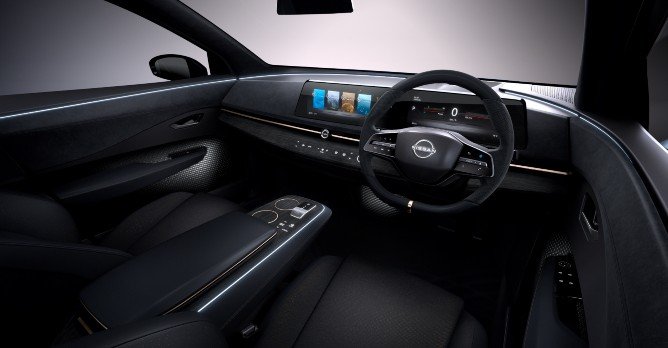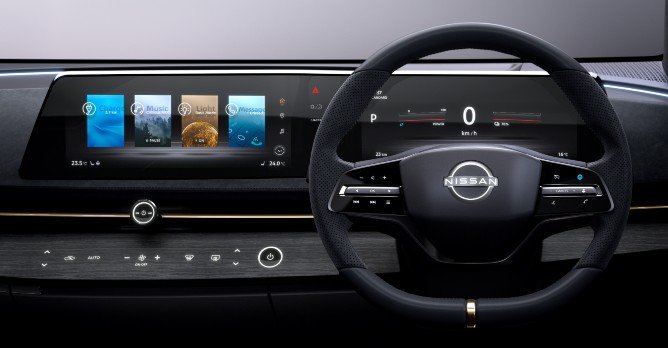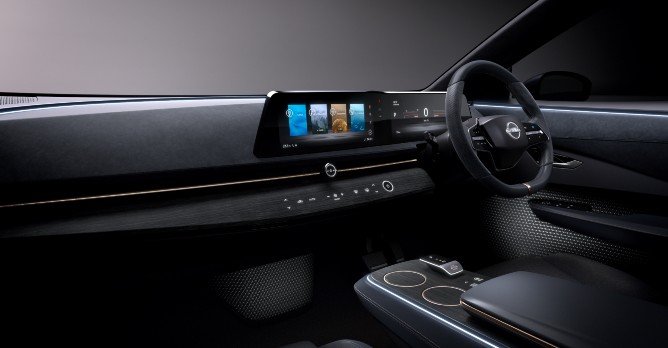Find out why Nissan does not use tablet displays
10 Apr 2020|242 views
It's a trend that's been hard to miss lately - many new cars have bulky, tablet-like screens smack in the middle of the dashboard.
While these super-sized displays may grab attention at motor shows, carmakers working to create next generation vehicles also have other things to consider as they attempt to balance design, technology and utility.

Instead of a tablet, the electric crossover has a curved, two-screen display reminiscent of a wave. It adds to the sense of a 'horizon' throughout the car, from elements in the door all the way to the rear of the cabin.
The layout reflects Nissan's new Timeless Japanese Futurism design language which is also expressed in the Ariya Concept's unique frontal 'shield'.
But the horizontal design wasn't chosen for its good looks alone as Tomomichi Uekuri, Senior Manager of Human Machine Interaction engineering team explains that the human eye naturally looks side to side when driving, hence information is absorbed better when the display is laid out horizontally, which also works well with peripheral vision.
The Nissan Ariya Concept's display keeps driving information in an instrument cluster location similar to that of a traditional car, while displaying entertainment information, comfort controls and system status in the centre screen.
Even though there are two screens, information can move or be swiped between them to create the feeling of a single display. For example, if you want your route directions and map in front of the steering wheel, they can appear there. They can also move to the centre, or disappear when no longer needed.
The display's wave construction is innovative and utilises an ergonomic layout for both the meter display and the centre display, not only for visibility, but also allows the driver to easily reach the centre display touch screen.

The user experience is even demonstrated at the granular level, allowing the driver to adjust how much data is shown in each location, removing unnecessary information from the driver's peripheral.
As a result, the sleek, seamless display looks like a natural, integrated part of the Nissan Ariya Concept's interior design - not a slab out of time and place.
It's a trend that's been hard to miss lately - many new cars have bulky, tablet-like screens smack in the middle of the dashboard.
While these super-sized displays may grab attention at motor shows, carmakers working to create next generation vehicles also have other things to consider as they attempt to balance design, technology and utility.

Instead of a tablet, the electric crossover has a curved, two-screen display reminiscent of a wave. It adds to the sense of a 'horizon' throughout the car, from elements in the door all the way to the rear of the cabin.
The layout reflects Nissan's new Timeless Japanese Futurism design language which is also expressed in the Ariya Concept's unique frontal 'shield'.
But the horizontal design wasn't chosen for its good looks alone as Tomomichi Uekuri, Senior Manager of Human Machine Interaction engineering team explains that the human eye naturally looks side to side when driving, hence information is absorbed better when the display is laid out horizontally, which also works well with peripheral vision.
The Nissan Ariya Concept's display keeps driving information in an instrument cluster location similar to that of a traditional car, while displaying entertainment information, comfort controls and system status in the centre screen.
Even though there are two screens, information can move or be swiped between them to create the feeling of a single display. For example, if you want your route directions and map in front of the steering wheel, they can appear there. They can also move to the centre, or disappear when no longer needed.
The display's wave construction is innovative and utilises an ergonomic layout for both the meter display and the centre display, not only for visibility, but also allows the driver to easily reach the centre display touch screen.

The user experience is even demonstrated at the granular level, allowing the driver to adjust how much data is shown in each location, removing unnecessary information from the driver's peripheral.
As a result, the sleek, seamless display looks like a natural, integrated part of the Nissan Ariya Concept's interior design - not a slab out of time and place.
Latest COE Prices
May 2025 | 1st BIDDING
NEXT TENDER: 21 May 2025
CAT A$103,009
CAT B$119,890
CAT C$62,590
CAT E$118,889
View Full Results Thank You For Your Subscription.





















